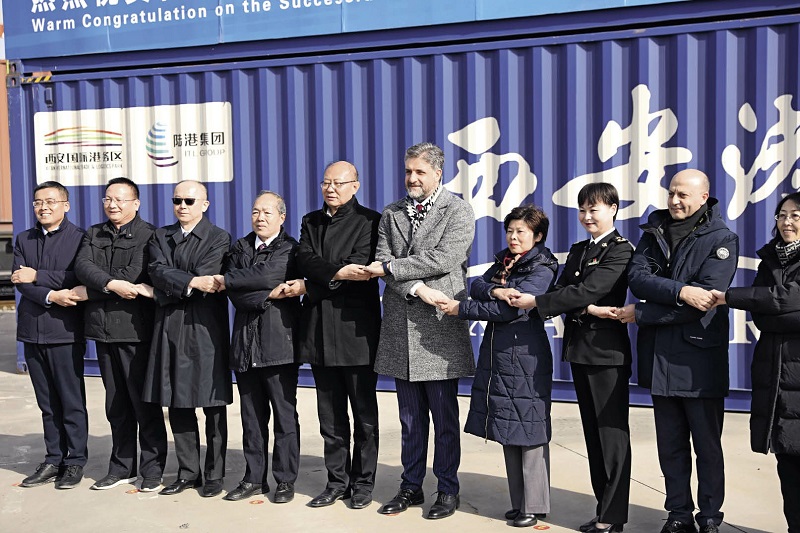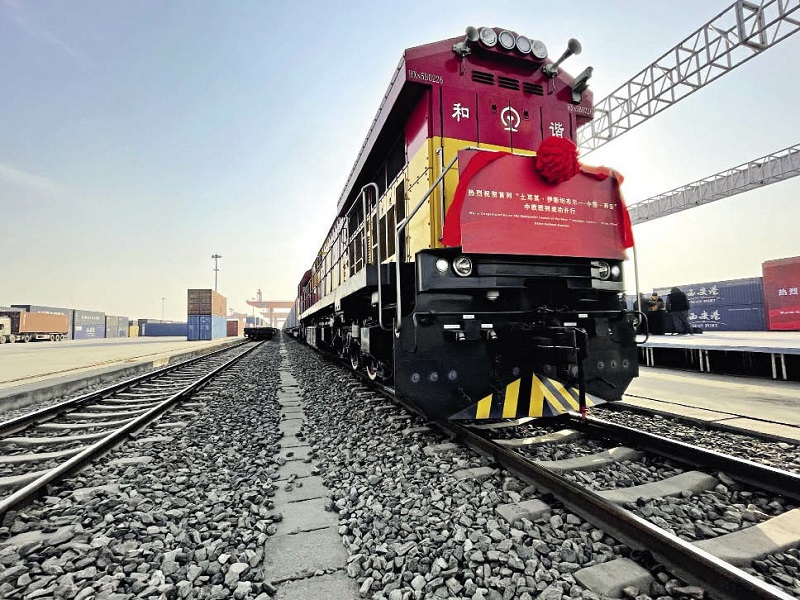The China-Europe Railway Express marks a significant phase towards integrated Eurasian rail transportation. The railway connection between two continents became even more vital during the pandemic when the freight trains played a crucial role in stabilizing the international logistics supply chain, due to limited air and maritime transport options. As part of the Belt and Road Initiative (BRI), which Turkey has supported from the beginning, this railway route has experienced a remarkable progress for the past 10 years and will continue its development.
Turkey, thanks to her unique geographical location, historically played a significant role in connecting Europe and Asia. It is manifested with the well-known Silk Road, and other cross-regional trade routes such as the Spice Road. Turkey’s strategic position at the intersection of Europe, Asia, and the Middle East further paves the way for her role as the “regional transportation hub,” which has gained a noticeable momentum in recent years.
Under the leadership of President Recep Tayyip Erdogan, massive infrastructure projects in Turkey, including highways, air and sea ports, and high-speed railways have greatly contributed to achieving Eurasian connectivity. For instance, the new airport in Istanbul, one of the world’s biggest, has the capacity to accommodate 200 million passengers annually. Moreover, we are constructing the Edirne-Kars High Speed Network which will enable faster and cheaper transport from China and Central Asia to Europe. The Yavuz Sultan Selim Bridge over the Bosphorus Strait, the Eurasia Tunnel and Marmaray, the Orhan Gazi Bridge over the Gulf of Izmit, logistics hubs, and communication infrastructures are all parts of this hybrid transportation network.

Representatives from China and Turkey at the launching ceremony of the direct freight train service from Xi’an to Istanbul on December 23, 2020.
There is now a special focus on transforming high-speed rail (HSR) in the country, with the goal of constructing an additional 5,500 kilometers of HSR and rapid lines by 2023. Turkey is the eighth HSR operating country in the world and the HSR lines between major cities (Ankara-Eskisehir-Konya) are operational and others (Ankara-Istanbul) are soon to be completed. With the aim to take advantage of the railways in carrying goods and products, various logistics centers have been constructed across the country.
Overall, Turkey’s perspective of regional integrated transport focuses on: building a modern Silk Road with dependable and viable alternative routes, promoting intermodal transport opportunities particularly on the Trans-Caspian International Transport Route (known as the Middle Corridor), upgrading and development of transport infrastructure, removing bottlenecks especially on border crossings, simplifying procedures, removing administrative barriers, enhancing logistics and corridor management capacities, and finally achieving cooperation and coordination with the transit countries.
As briefly mentioned above, some of these recent mega-construction projects in Turkey are materialized with Chinese investment, and more are being planned. Turkey has already started delivering on concrete projects in the fields of transportation, logistics, energy, and trade for reviving the ancient Silk Road. Further developments in this regard will make Turkey’s geographic advantage more visible. All of these projects initiated by Turkey will be readily integrated into the Middle Corridor (MC), which will constitute a cost effective and secure route from Asia to Europe.
The China-Europe Railway Express has also benefited from this ongoing construction and improvement of railways, facilities, and its services. The initiation of a direct freight train service between Turkey and China in December 2020 was the most recent and substantial example of this development. The train followed the MC via Baku-Tbilisi-Kars (BTK) railway. Its route covers almost 8,700 kilometers, passing through two continents, two seas, and five countries, forwarding its freight from Istanbul to Xi’an in less than two weeks. In short, “once a distant dream” finally became possible. There are plans to make a regular and more frequent weekly schedule of freight trains between Turkey and China.
Xi’an, as the eastern end to the Silk Road and capital of China in ancient times, was once the meeting and melting point of ancient Turks and Chinese, as well as the destination of social and commercial interactions for many other countries. Our ancestors were well aware of the importance of safe and stable transport routes for enhancing economic activities. That is why they created a road that enabled the transportation of goods between Asia and Europe. Today, after many centuries, we again follow their path. We are building a modern Silk Road, with the opportunities provided by technology and modernization.
I would like to briefly point out the developments and some highlights on Turkey’s MC Initiative that is expected to play a bigger role in Eurasian connectivity as a reliable alternative option among others for the following reasons:
First of all, the shift of economic gravity towards the East generates a continuous growth in the transport of goods between Asia and Europe. The pandemic did not alter this trend; it has even strengthened it. For instance, the bilateral trade volume between Turkey and China reached US $26 billion in 2020. It is one of the highest figures of any bilateral commerce between European and Asian countries.
It should also be noted that the further use of the railway connection between Turkey and China will accelerate economic activities across Eurasia and this in return will be beneficial for our bilateral economic relations. Turkish and Chinese products will be more easily delivered through the freight trains. Highly qualified Turkish brands and products, which are well sought-after in many parts of the world, will become more available in the vast Chinese market. Particularly, they will be integrated into e-commerce platforms in China. We therefore encourage Turkish and Chinese businesspeople to make better use of Turkey-China freight trains which opened up as a new commercial gate between the two countries.
Secondly, with a population of 84 million, Turkey is serving not only as a regional transportation hub but also as a bridge between three continents, and for a wide range of markets in the Balkans, the Caucasus, Central Asia, the Middle East, and North Africa. Turkey’s customs union with the EU allows direct access to the EU market; while her free trade agreements with 28 countries mean a free access from Turkey to almost one billion people.

The first train bound for Turkey’s economic center Istanbul departs from northwest China’s Xi’an on December 23, 2020, officially marking the initiation of the direct freight train service between Turkey and China.
Thirdly, the most essential infrastructure for the operationalization of the MC has been completed. BTK railway, with a total track length of 840 kilometers, became fully operational in 2017. An uninterrupted railway line now connects Beijing to London through the Caspian Sea and the Bosphorus. It was used by a China-Europe freight train for the first time in November 2019. BTK has an initial capacity of 1 million passengers and 6.5 million tons of cargo per annum, to be increased to 3 million passengers and 17 million tons of cargo per annum by 2034.
Fourth, there are clear opportunities presented by the Middle Corridor: it brings a complementary route to the northern and southern alternatives as well as supplements China-Central Asia-West Asia Economic Corridor under the BRI. MC stands as a credible alternative by itself in China-Europe Express because relying too much on just one existing route is not a safe approach. The blockage incident in the Suez Canal in March 2021 proved once again the importance of having alternative routes. Indeed, one of the main logics behind the BRI is to create feasible alternative transportation routes. The use of MC in both directions between Europe and Asia will be compatible with this logic. Therefore, MC presents a faster and shorter connection to the Balkans, as well as West and Northern Europe. Additionally, the MC route has favorable climatic conditions during winters, which will be advantageous in transporting non-durable food and agricultural products.
Finally, there is a strong political will between Turkey and China to enhance their cooperation in this area as exemplified by President Erdogan and President Xi Jinping. Turkey has been one of the earliest supporters of the BRI. Our MC Initiative also has a natural complementarity with the BRI. In 2015, Turkey and China signed a MoU to further align the BRI and the MC. Turkey and China have similar outlooks for deepening regional economic cooperation on the vast Eurasian landmass via transport corridors. The relevant Turkish and Chinese authorities are planning to hold a high-level joint working group meeting in the foreseeable future to discuss and plan toward this end.
In conclusion, the rapid global transformation is marked by the rise of the Asian continent and the connectivity projects. The deepening Turkish-Chinese cooperation in transportation and logistics sectors will surely result in more prosperity and stability across Eurasia. Much has been achieved thanks to the fruitful cooperation between the two countries. The recent initiation of the direct freight trains between Turkey-China was one of the most successful examples of this cooperation. Broader opportunities of collaboration are within our reach as long as we continue to galvanize our joint efforts toward common interests.
ABDULKADIR EMIN ONEN is the ambassador of Turkey to China.